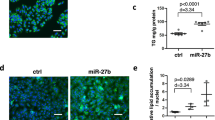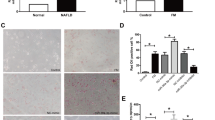Abstract
Non-alcoholic fatty liver disease is a multifactorial disorder with complicated pathophysiology ranging from simple steatosis to steatohepatitis and liver fibrosis. Trimethylamine-N-oxide (TMAO) production is believed to be correlated with choline deficiency. This study investigated the expression of miRNA-34a, miRNA-122, and miRNA-192 in the fatty liver cell model treated with different concentrations of TMAO. A fatty liver cell model was developed by exposing HepG2 cells to a mixture of palmitate and oleate in a ratio of 1:2 at a final concentration of 1200 μM for 24 h. The confirmed fatty liver cells were treated with 37.5, 75, 150, and 300 μM of TMAO for 24 h. RT-qPCR was used to quantify the expression of microRNAs in a cellular model. The cellular expression of all microRNAs was significantly higher in treated fatty liver cells compared to normal HepG2 cells (P < 0.05). Only 75 and 150 µM of TMAO significantly increased the expression of miRNA-34a and miRNA-122 compared to both fatty and normal control cells (P < 0.05). Our results provided an experimental documentation for the potential effect of TMAO to change the expression of miR-34a and miR-22 as a mechanism for contributing to the pathogenesis of non-alcoholic fatty liver disease.




Similar content being viewed by others
Data Availability
All data generated or analyzed in this study are available upon reasonable request.
References
Abdolahi A, Vahabzadeh Z, Izadpanah E, Moloudi MR (2022) Vaspin attenuates steatosis-induced fibrosis via GRP78 receptor by targeting AMPK signaling pathway. J Physiol Biochem 78(1):185–197
Baranova A, Maltseva D, Tonevitsky A (2019) Adipose may actively delay progression of NAFLD by releasing tumor-suppressing, anti-fibrotic miR-122 into circulation. Obes Rev 20(1):108–118
Béres NJ, Szabó D, Kocsis D, Szűcs D, Kiss Z, Müller KE, Lendvai G, Kiss A, Arató A, Sziksz E (2016) Role of altered expression of miR-146a, miR-155, and miR-122 in pediatric patients with inflammatory bowel disease. Inflamm Bowel Dis 22(2):327–335
Boumelhem BB, Pilgrim C, Zwicker VE, Kolanowski JL, Yeo JH, Jolliffe KA, New EJ, Day ML, Assinder SJ, Fraser ST (2022) Intracellular flow cytometric lipid analysis—a multiparametric system to assess distinct lipid classes in live cells. J Cell Sci 135(5):jcs258322
Chen ML, Yi L, Zhang Y, Zhou X, Ran L, Yang J, Zhu JD, Zhang Q-Y, Mi MT (2016a) Resveratrol attenuates trimethylamine-N-oxide (TMAO)-induced atherosclerosis by regulating TMAO synthesis and bile acid metabolism via remodeling of the gut microbiota. Mbio 7(2):e02210-02215
Chen YM, Liu Y, Zhou RF, Chen XL, Wang C, Tan XY, Wang LJ, Zheng RD, Zhang HW, Ling WH (2016b) Associations of gut-flora-dependent metabolite trimethylamine-N-oxide, betaine and choline with non-alcoholic fatty liver disease in adults. Sci Rep 6(1):1–9
Cheung O, Puri P, Eicken C, Contos MJ, Mirshahi F, Maher JW, Kellum JM, Min H, Luketic VA, Sanyal AJ (2008) Nonalcoholic steatohepatitis is associated with altered hepatic MicroRNA expression. Hepatology 48(6):1810–1820
Cornatzer W (1955) Lipotropic action of choline in liver disease. J Lancet 75(3):114–117
Dai X, Hou H, Zhang W, Liu T, Li Y, Wang S, Wang B, Cao H (2020) Microbial metabolites: critical regulators in NAFLD. Front Microbiol 11:567654
Díez-Ricote L, Ruiz-Valderrey P, Micó V, Blanco-Rojo R, Tomé-Carneiro J, Dávalos A, Ordovás JM, Daimiel L (2021) Trimethylamine n-oxide (TMAO) modulates the expression of cardiovascular disease-related microRNAs and their targets. Int J Mol Sci 22(20):11145
Ding J, Li M, Wan X, Jin X, Chen S, Yu C, Li Y (2015a) Effect of miR-34a in regulating steatosis by targeting PPARα expression in nonalcoholic fatty liver disease. Sci Rep 5(1):1–10
Ding J, Li M, Wan X, Jin X, Chen S, Yu C, Li Y (2015b) Effect of miR-34a in regulating steatosis by targeting PPARα expression in nonalcoholic fatty liver disease. Sci Rep 5(1):13729
Ding L, Chang M, Guo Y, Zhang L, Xue C, Yanagita T, Zhang T, Wang Y (2018) Trimethylamine-N-oxide (TMAO)-induced atherosclerosis is associated with bile acid metabolism. Lipids Health Dis 17(1):1–8
Dongiovanni P, Meroni M, Longo M, Fargion S, Fracanzani AL (2018) miRNA signature in NAFLD: a turning point for a non-invasive diagnosis. Int J Mol Sci 19(12):3966
Ezaz G, Trivedi HD, Connelly MA, Filozof C, Howard K, Parrish ML, Kim M, Herman MA, Nasser I, Afdhal NH (2020) Differential associations of circulating MicroRNAs with pathogenic factors in NAFLD. Hepatology Communications 4(5):670–680
Flores-Guerrero JL, Post A, van Dijk PR, Connelly MA, Garcia E, Navis G, Bakker SJ, Dullaart RP (2021) Circulating trimethylamine-N-oxide is associated with all-cause mortality in subjects with nonalcoholic fatty liver disease. Liver Int 41(10):2371–2382
Friedman SL, Neuschwander-Tetri BA, Rinella M, Sanyal AJ (2018) Mechanisms of NAFLD development and therapeutic strategies. Nat Med 24(7):908–922
Ganz M, Szabo G (2013) Immune and inflammatory pathways in NASH. Hep Intl 7(2):771–781
Gjorgjieva M, Sobolewski C, Ay AS, Abegg D, Correia de Sousa M, Portius D, Berthou F, Fournier M, Maeder C, Rantakari P (2020) Genetic ablation of miR-22 fosters diet-induced obesity and NAFLD development. J Personal Med 10(4):170
Greenspan P, Mayer EP, Fowler SD (1985) Nile red: a selective fluorescent stain for intracellular lipid droplets. J Cell Biol 100(3):965–973
Gunn PJ, Green CJ, Pramfalk C, Hodson L (2017) In vitro cellular models of human hepatic fatty acid metabolism: differences between Huh7 and HepG2 cell lines in human and fetal bovine culturing serum. Physiol Rep 5(24):e13532
Gurtan AM, Sharp PA (2013) The role of miRNAs in regulating gene expression networks. J Mol Biol 425(19):3582–3600
Huang R, Duan X, Fan J, Li G, Wang B (2019) Role of noncoding RNA in development of nonalcoholic fatty liver disease. BioMed Res Int. https://doi.org/10.1155/2019/8690592
Jampoka K, Muangpaisarn P, Khongnomnan K, Treeprasertsuk S, Tangkijvanich P, Payungporn S (2018) Serum miR-29a and miR-122 as potential biomarkers for non-alcoholic fatty liver disease (NAFLD). Microrna 7(3):215–222
Li M, Guo K, Vanella L, Taketani S, Adachi Y, Ikehara S (2015) Stem cell transplantation upregulates Sirt1 and antioxidant expression, ameliorating fatty liver in type 2 diabetic mice. Int J Biol Sci 11(4):472
Li C, Deng M, Hu J, Li X, Chen L, Ju Y, Hao J, Meng S (2016) Chronic inflammation contributes to the development of hepatocellular carcinoma by decreasing miR-122 levels. Oncotarget 7(13):17021
Li Z, Wu Z, Yan J, Liu H, Liu Q, Deng Y, Ou C, Chen M (2019) Gut microbe-derived metabolite trimethylamine N-oxide induces cardiac hypertrophy and fibrosis. Lab Invest 99(3):346–357
Liu Y, Dai M (2020) Trimethylamine N-oxide generated by the gut microbiota is associated with vascular inflammation: new insights into atherosclerosis. Med Inflam. https://doi.org/10.1155/2020/4634172
Liu XL, Cao HX, Fan JG (2016) MicroRNAs as biomarkers and regulators of nonalcoholic fatty liver disease. J Dig Dis 17(11):708–715
Liu XL, Cao HX, Wang BC, Xin FZ, Zhang RN, Zhou D, Yang RX, Zhao ZH, Pan Q, Fan JG (2017) miR-192-5p regulates lipid synthesis in non-alcoholic fatty liver disease through SCD-1. World J Gastroenterol 23(46):8140
Liu X, Shao Y, Tu J, Sun J, Li L, Tao J, Chen J (2021) Trimethylamine-n-oxide-stimulated hepatocyte-derived exosomes promote inflammation and endothelial dysfunction through nuclear factor-kappa b signaling. Ann Transl Med. https://doi.org/10.21037/atm-21-5043
Long JK, Dai W, Zheng YW, Zhao S-P (2019) miR-122 promotes hepatic lipogenesis via inhibiting the LKB1/AMPK pathway by targeting Sirt1 in non-alcoholic fatty liver disease. Mol Med 25(1):1–13
Min HK, Kapoor A, Fuchs M, Mirshahi F, Zhou H, Maher J, Kellum J, Warnick R, Contos MJ, Sanyal AJ (2012) Increased hepatic synthesis and dysregulation of cholesterol metabolism is associated with the severity of nonalcoholic fatty liver disease. Cell Metab 15(5):665–674
Mohammadi A, Vahabzadeh Z, Jamalzadeh S, Khalili T (2018) Trimethylamine-N-oxide, as a risk factor for atherosclerosis, induces stress in J774A. 1 murine macrophages. Adv Med Sci 63(1):57–63
Panera N, Gnani D, Crudele A, Ceccarelli S, Nobili V, Alisi A (2014) MicroRNAs as controlled systems and controllers in non-alcoholic fatty liver disease. World J Gastroenterol: WJG 20(41):15079
Patell R, Dosi R, Joshi H, Sheth S, Shah P, Jasdanwala S (2014) Non-alcoholic fatty liver disease (NAFLD) in obesity. J Clin Diagn Res: JCDR 8(1):62
Purushotham A, Schug TT, Xu Q, Surapureddi S, Guo X, Li X (2009) Hepatocyte-specific deletion of SIRT1 alters fatty acid metabolism and results in hepatic steatosis and inflammation. Cell Metab 9(4):327–338
Raitoharju E, Seppälä I, Lyytikäinen LP, Viikari J, Ala-Korpela M, Soininen P, Kangas AJ, Waldenberger M, Klopp N, Illig T (2016) Blood hsa-miR-122-5p and hsa-miR-885-5p levels associate with fatty liver and related lipoprotein metabolism—the young finns study. Sci Rep 6(1):1–13
Rath S, Rud T, Pieper DH, Vital M (2020) Potential TMA-producing bacteria are ubiquitously found in mammalia. Front Microbiol 10:2966
Salman M, Kamel MA, El-Nabi SEH, Ismail AHA, Ullah S, Al-Ghamdi A, Hathout HM, El-Garawani IM (2022) The regulation of HBP1, SIRT1, and SREBP-1c genes and the related microRNAs in non-alcoholic fatty liver rats: The association with the folic acid anti-steatosis. PLoS ONE 17(4):e0265455
Seldin MM, Meng Y, Qi H, Zhu W, Wang Z, Hazen SL, Lusis AJ, Shih DM (2016) Trimethylamine N-oxide promotes vascular inflammation through signaling of mitogen-activated protein kinase and nuclear factor-κB. J Am Heart Assoc 5(2):e002767
Shih DM, Wang Z, Lee R, Meng Y, Che N, Charugundla S, Qi H, Wu J, Pan C, Brown JM (2015) Flavin containing monooxygenase 3 exerts broad effects on glucose and lipid metabolism and atherosclerosis [S]. J Lipid Res 56(1):22–37
Szabo G, Bala S (2013) MicroRNAs in liver disease. Nat Rev Gastroenterol Hepatol 10(9):542–552
Wang Z, Klipfell E, Bennett BJ, Koeth R, Levison BS, DuGar B, Feldstein AE, Britt EB, Fu X, Chung YM (2011) Gut flora metabolism of phosphatidylcholine promotes cardiovascular disease. Nature 472(7341):57–63
Xu Y, Zalzala M, Xu J, Li Y, Yin L, Zhang Y (2015) A metabolic stress-inducible miR-34a-HNF4α pathway regulates lipid and lipoprotein metabolism. Nat Commun 6(1):1–11
Yang S, Li X, Yang F, Zhao R, Pan X, Liang J, Tian L, Li X, Liu L, Xing Y (2019) Gut microbiota-dependent marker TMAO in promoting cardiovascular disease: inflammation mechanism, clinical prognostic, and potential as a therapeutic target. Front Pharmacol 10:1360
Funding
This study was conducted as a dissertation of a master's student in clinical biochemistry. The study was supported financially by vice chancellor in research of Kurdistan University of Medical Sciences [grant numbers IR.MUK.REC.1398.315].
Author information
Authors and Affiliations
Contributions
ZB carried out the sample collection, all laboratory works, and final report preparation. MRM has given advice on the project and assisted with manuscript preparation. MM contributes to statistical analysis and writing manuscript. AA helped with sample collection. ZV carried out the design, supervised the study, and prepared the manuscript. The manuscript’s contents have been read and approved by all authors. The authors declare that they have no conflict of interest.
Corresponding author
Ethics declarations
Competing interests
The authors declare that they have no competing financial interest and nothing to disclose.
Additional information
Publisher's Note
Springer Nature remains neutral with regard to jurisdictional claims in published maps and institutional affiliations.
Rights and permissions
Springer Nature or its licensor (e.g. a society or other partner) holds exclusive rights to this article under a publishing agreement with the author(s) or other rightsholder(s); author self-archiving of the accepted manuscript version of this article is solely governed by the terms of such publishing agreement and applicable law.
About this article
Cite this article
Bahramirad, Z., Moloudi, M.R., Moradzad, M. et al. Trimethylamine-N-oxide, a New Risk Factor for Non-alcoholic Fatty Liver Disease Changes the Expression of miRNA-34a, and miRNA-122 in the Fatty Liver Cell Model. Biochem Genet (2024). https://doi.org/10.1007/s10528-024-10754-0
Received:
Accepted:
Published:
DOI: https://doi.org/10.1007/s10528-024-10754-0




